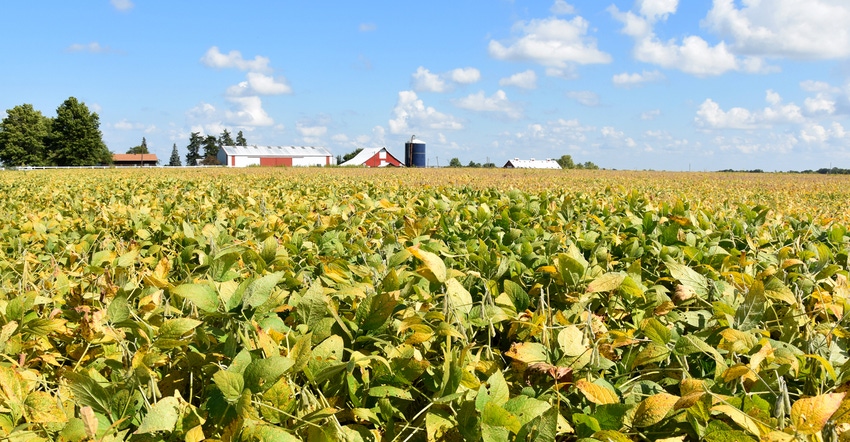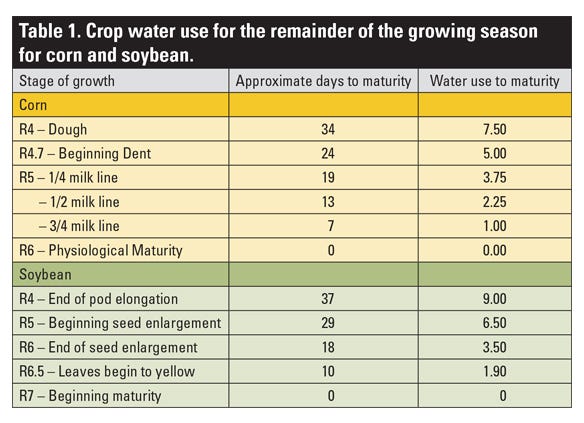September 2, 2020

What a year 2020 has been. After a year of record flooding over much of Nebraska, we are now in various stages of drought. With limited rainfall over most of the state this year and fairly extended hot, dry periods, many irrigators may be wondering when the irrigation season is going to end.
With the price of grain, it also is worth considering if you need to apply that last inch or two of water to get that last bushel or two. Scheduling the last irrigation can reduce your pumping costs, improve harvest conditions, and in allocated groundwater areas, may save some irrigation water for next year.
Usually by mid- to late August, corn and soybeans have progressed enough in maturity that we have a good handle on how much water it will take to finish the crop out. Depending on soil type, some fields may have enough stored soil water to get the crop to maturity without additional irrigation or rainfall.
So, just how much water do we need to finish out the growing season? The accompanying table gives you a good idea of the amount of water needed based on the growth stage of the crop.

During the heart of the irrigation season, we recommend keeping the available soil water level above the 50% depletion level. To do this, we recommend irrigating as the soil water level approaches 35% depletion. This will allow a few days for the irrigation to be completed before the crop experiences any stress.
As we near the end of the season, we can push the threshold to 60% depletion. The crop is using water at a lower rate per day, so that allows us to use more than the 50% depletion and from a deeper depth.
The water-holding capacity of soil varies with its texture and needs to be considered when determining how much soil water is available. For example, loamy sand will hold about 1.1 inches of water per foot or 4.4 inches in the top 4 feet, while a silt loam soil can hold 2.2 inches per foot or 8.8 inches in the top 4 feet.
If the silt loam is at field capacity and we draw down the available soil water to 40% (60% depletion), we would have about 5.3 inches of useable water in the top 4 feet of soil.
From the table, corn at the beginning dent stage needs 5 inches of water to reach maturity. Using the silt loam soil from above, the example field would have enough water to reach maturity and have an estimated 0.3 inches to spare if the corn is beginning to dent (5.3 − 5.0 = 0.3 inches).
The loamy sand, at field capacity, would have 2.6 inches available above the 40% (60% depletion) level. This field would need an additional 2.4 inches of water to reach maturity.
The other thing to keep in mind is expected rainfall through crop maturity. While many parts of the state are dry, keep in mind the long-term average rainfall for this time of year.
One thing to note is that the time needed for corn to mature is dependent on growing degree days. If corn needs 5 inches of water to reach maturity and we receive some hot, dry, windy days in early September, the corn will still use 5 inches. It will just finish up a few days quicker.
In contrast, soybean maturity is dependent on day length. Because soybeans may use more or less water than the averages listed in the table, and because it may be difficult to determine the actual correct growth stage, it is important to continue to monitor soil water until maturity.
This is where tools such as an ETgage and soil water sensors come into play. An ETgage will give you potential crop water use, and the soil water sensors will give you an idea of how much water is stored in the soil profile. Then you will be able to determine how much water the crop will need in either irrigation or precipitation to finish out the year.
For more information on this topic, check out NebGuide G1871, "Predicting the Last Irrigation of the Season," and the CropWatch article "Scheduling the Last Irrigations in a Year with Delayed Crop Maturity."
Burr is a Nebraska Extension crops and water educator. Nygren is a Nebraska Extension educator.
Source: UNL CropWatch, which is solely responsible for the information provided and is wholly owned by the source. Informa Business Media and all its subsidiaries are not responsible for any of the content contained in this information asset.
You May Also Like




